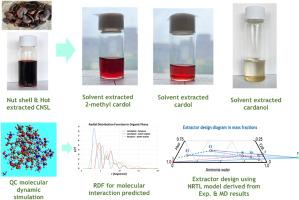溶剂萃取法从生物废弃物中高效分离腰果酚、腰果酚和2-甲基腰果酚
IF 5.8
2区 生物学
Q1 AGRICULTURAL ENGINEERING
引用次数: 0
摘要
腰果酚是腰果加工过程中产生的一种生物废弃物——腰果壳,用于生产环氧树脂、聚氨酯、表面活性剂和各种高分子材料。本研究提出溶剂萃取法作为一种高效分离腰果果仁液中腰果酚、腰果酚和2-甲基腰果酚的技术,以替代高能耗的薄膜蒸馏。为了开发所提出的工艺,实验测量了液-液平衡(LLE),并辅以量子化学分子动力学模拟,从而建立了萃取工艺设计所需的热力学模型。分子动力学模拟结果提供了描述分子对间相互作用的径向分布函数(RDFs),阐明了正己烷选择性提取腰果酚的机理。针对分离工艺的发展,提出了连续引入纯溶剂和混合溶剂的方法,并采用气相色谱/质谱法对分离产物进行了检测。最后,设计了一种用己烷从氨水溶液中回收腰果酚的萃取器。本文章由计算机程序翻译,如有差异,请以英文原文为准。

Energy-efficient separation of cardanol, cardol, and 2-methyl cardol from biowaste using solvent extraction
Cardanol is yielded from cashew nutshells, known as a biowaste of cashew nut processing, and is used in the production of epoxy resin, polyurethane, surfactants, and various polymer materials. This study proposes solvent extraction as an energy-efficient separation technique for cardanol, cardol, and 2-methyl cardol from cashew nutshell liquid as an alternative to energy-intensive thin-film distillation. To develop the proposed process, the liquid-liquid equilibrium (LLE) was experimentally measured and supplemented by quantum chemical molecular dynamics simulations, enabling the formulation of the thermodynamic model necessary for the extraction process design. The molecular dynamic simulation results provided radial distribution functions (RDFs), which described the molecular interactions between pairs of molecules, clarifying the selective extraction of cardanol with hexane. For the development of the separation process, a sequential solvent introduction of pure and mixed solvents was proposed, and the separation products were examined using gas chromatography/mass spectrometry. Finally, an extractor design for cardanol recovery from an aqueous ammonia solution using hexane is presented.
求助全文
通过发布文献求助,成功后即可免费获取论文全文。
去求助
来源期刊

Biomass & Bioenergy
工程技术-能源与燃料
CiteScore
11.50
自引率
3.30%
发文量
258
审稿时长
60 days
期刊介绍:
Biomass & Bioenergy is an international journal publishing original research papers and short communications, review articles and case studies on biological resources, chemical and biological processes, and biomass products for new renewable sources of energy and materials.
The scope of the journal extends to the environmental, management and economic aspects of biomass and bioenergy.
Key areas covered by the journal:
• Biomass: sources, energy crop production processes, genetic improvements, composition. Please note that research on these biomass subjects must be linked directly to bioenergy generation.
• Biological Residues: residues/rests from agricultural production, forestry and plantations (palm, sugar etc), processing industries, and municipal sources (MSW). Papers on the use of biomass residues through innovative processes/technological novelty and/or consideration of feedstock/system sustainability (or unsustainability) are welcomed. However waste treatment processes and pollution control or mitigation which are only tangentially related to bioenergy are not in the scope of the journal, as they are more suited to publications in the environmental arena. Papers that describe conventional waste streams (ie well described in existing literature) that do not empirically address ''new'' added value from the process are not suitable for submission to the journal.
• Bioenergy Processes: fermentations, thermochemical conversions, liquid and gaseous fuels, and petrochemical substitutes
• Bioenergy Utilization: direct combustion, gasification, electricity production, chemical processes, and by-product remediation
• Biomass and the Environment: carbon cycle, the net energy efficiency of bioenergy systems, assessment of sustainability, and biodiversity issues.
 求助内容:
求助内容: 应助结果提醒方式:
应助结果提醒方式:


